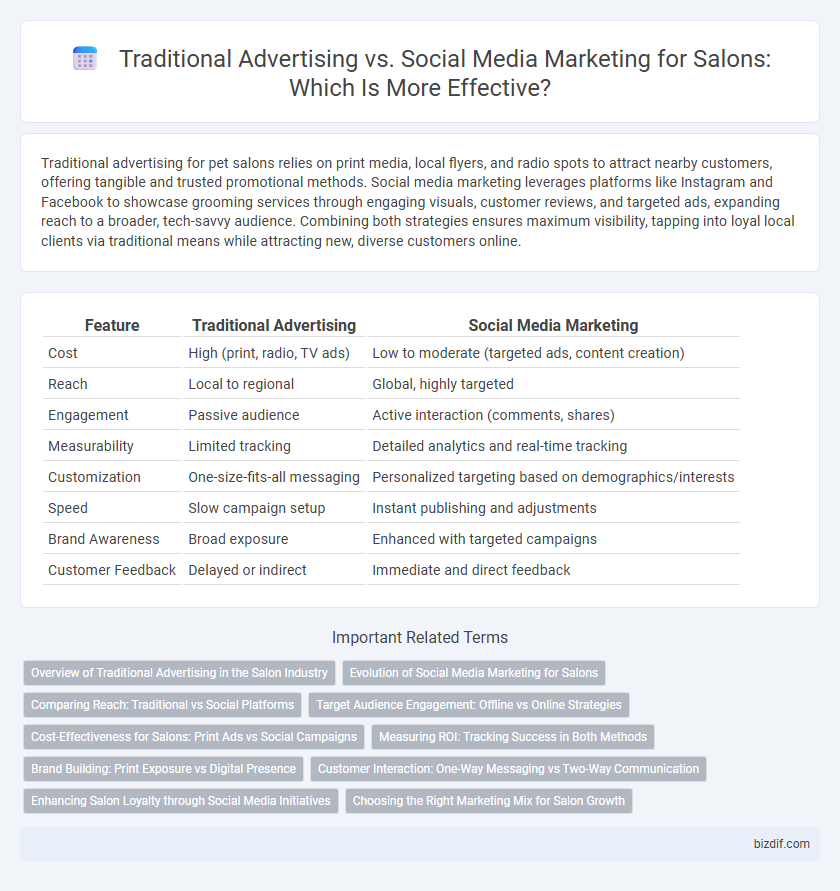Traditional advertising for pet salons relies on print media, local flyers, and radio spots to attract nearby customers, offering tangible and trusted promotional methods. Social media marketing leverages platforms like Instagram and Facebook to showcase grooming services through engaging visuals, customer reviews, and targeted ads, expanding reach to a broader, tech-savvy audience. Combining both strategies ensures maximum visibility, tapping into loyal local clients via traditional means while attracting new, diverse customers online.
Table of Comparison
| Feature | Traditional Advertising | Social Media Marketing |
|---|---|---|
| Cost | High (print, radio, TV ads) | Low to moderate (targeted ads, content creation) |
| Reach | Local to regional | Global, highly targeted |
| Engagement | Passive audience | Active interaction (comments, shares) |
| Measurability | Limited tracking | Detailed analytics and real-time tracking |
| Customization | One-size-fits-all messaging | Personalized targeting based on demographics/interests |
| Speed | Slow campaign setup | Instant publishing and adjustments |
| Brand Awareness | Broad exposure | Enhanced with targeted campaigns |
| Customer Feedback | Delayed or indirect | Immediate and direct feedback |
Overview of Traditional Advertising in the Salon Industry
Traditional advertising in the salon industry includes print ads in local magazines, flyers, radio spots, and billboards that target geographically specific audiences. These methods build brand awareness through consistent visual and auditory exposure, often relying on repetitive messaging to attract walk-in clients. Despite the rise of digital platforms, traditional advertising remains effective for salons seeking to reach older demographics and maintain a strong community presence.
Evolution of Social Media Marketing for Salons
Social media marketing for salons has evolved from basic profile pages to dynamic platforms featuring targeted ads, influencer partnerships, and interactive content, significantly increasing customer engagement and retention. Unlike traditional advertising methods such as print and radio, social media enables real-time feedback and personalized promotions, enhancing brand loyalty and expanding reach. Platforms like Instagram and TikTok prioritize visual storytelling, making them ideal for showcasing salon services and trends, driving appointment bookings and client interaction.
Comparing Reach: Traditional vs Social Platforms
Traditional advertising in salons typically targets local audiences through mediums like print, radio, and billboards, offering a limited but geographically focused reach. Social media marketing extends the salon's reach globally, leveraging platforms such as Instagram, Facebook, and TikTok to engage millions of potential clients through targeted ads and influencer partnerships. Analytics tools on social platforms provide real-time data on audience demographics and engagement, enabling salons to optimize campaigns more effectively than traditional advertising methods.
Target Audience Engagement: Offline vs Online Strategies
Traditional advertising in salons relies on offline strategies such as print ads, flyers, and local events to target nearby customers, creating physical presence and immediate brand recognition. Social media marketing leverages online platforms like Instagram and Facebook, utilizing targeted ads and interactive content to engage a broader audience with personalized messaging. The effectiveness of social media lies in its ability to track user behavior and preferences, enabling salons to refine campaigns and foster stronger customer relationships through real-time interaction.
Cost-Effectiveness for Salons: Print Ads vs Social Campaigns
Print ads in traditional salon advertising typically require higher upfront costs for design, printing, and distribution, limiting flexibility and measurable ROI. Social media marketing campaigns offer cost-effective alternatives with targeted reach, dynamic content options, and real-time performance tracking, enabling salons to optimize budgets efficiently. Leveraging platforms like Instagram and Facebook allows salons to engage clients directly, reducing overall advertising expenses while maximizing visibility and customer acquisition.
Measuring ROI: Tracking Success in Both Methods
Measuring ROI in traditional advertising relies heavily on quantifiable metrics such as coupon redemptions, foot traffic increases, and direct sales lift post-campaign, making it straightforward but sometimes limited in scope. Social media marketing offers advanced analytics tools that track engagement rates, click-through conversions, and customer sentiment in real-time, providing a more nuanced understanding of campaign effectiveness. Combining CRM data with social media insights enables salons to optimize marketing budgets by identifying the most cost-effective channels and strategies for client acquisition and retention.
Brand Building: Print Exposure vs Digital Presence
Traditional advertising in salons, such as print exposure through magazines and flyers, establishes local brand recognition with tactile engagement and trusted credibility. Social media marketing amplifies brand building by expanding digital presence, driving real-time interaction, and fostering customer loyalty through visual storytelling and targeted campaigns. Combining print exposure with a strong social media strategy maximizes salon visibility and strengthens overall brand identity.
Customer Interaction: One-Way Messaging vs Two-Way Communication
Traditional advertising in salons relies on one-way messaging through methods like print ads and flyers, limiting direct customer interaction and feedback. Social media marketing facilitates two-way communication by enabling salons to engage customers through comments, messages, and reviews, fostering real-time dialogue and personalized experiences. This interactive approach enhances customer loyalty and helps salons adapt services based on client input.
Enhancing Salon Loyalty through Social Media Initiatives
Traditional advertising relies on print ads, flyers, and local media to reach potential salon clients, but social media marketing offers targeted engagement and real-time interaction, which significantly boost client loyalty. Social platforms enable salons to share personalized content, showcase transformations, and run exclusive promotions, fostering a sense of community and encouraging repeat visits. Leveraging tools like Instagram Stories, Facebook Groups, and influencer partnerships enhances brand visibility and deepens customer relationships beyond conventional advertising methods.
Choosing the Right Marketing Mix for Salon Growth
Traditional advertising in salons, including print ads and local radio spots, effectively target a geographically specific audience and build brand credibility through established channels. Social media marketing leverages platforms like Instagram and Facebook to engage customers with visually appealing content, promotions, and real-time interactions, driving higher customer retention and new client acquisition. Combining traditional advertising with a strong social media presence creates a balanced marketing mix that maximizes salon growth and brand visibility.
Traditional Advertising vs Social Media Marketing Infographic

 bizdif.com
bizdif.com